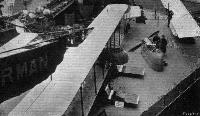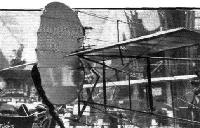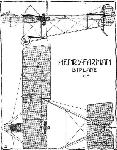J.Davilla, A.Soltan French Aircraft of the First World War (Flying Machines)
Henri Farman H.F.24
The H.F.24 was similar to the H.F.20, but the central nacelle was mounted on the top wing instead of the lower. The nacelle held the pilot, engine, and fuel and oil tanks and was also shorter and smaller than those used on previous versions of the H.F.20. It is unclear what advantage this layout would have had over the previous configurations, although the rearward view of the observer and pilot would certainly have been improved. The engine was an 80-hp Gnome Lambda. The plane was built in 1913.
The Farman H.F.24 represented a significant departure from Henri Farman's preceding designs. It was a small sesquiplane intended as a trainer or aerobatic machine (to perform loops). The lower wing span was only 3.75 m. The undercarriage was unique for a Farman design, featuring two independent wheels in order to ensure stability on the ground. As far as can be determined no H.F.24s were purchased by the Aviation Militaire and none is known to have been purchased by foreign air services.
H.F.24 Aerobatic Sesquiplane with 80-hp Gnome Lambda
Span 11.50 m; length 8.75 m; height 3.750 m; wing area 23 sq. m
Empty weight 250 kg; loaded weight 501 kg
Maximum speed: 11 5 km/h; climb to 2,000 m in 16 minutes
Probably only one built
Показать полностью
L.Opdyke French Aeroplanes Before the Great War (Schiffer)
Deleted by request of (c)Schiffer Publishing
HF24: This curious biplane was shown at the 1913 Salon beside a Maurice Farman. The top wing was much longer than the lower, and the nacelle was attached to its underside, the rotary engine and pusher propeller at its aft end between the outriggers. The single rudder was oval, behind the single tailplane. The wheels were attached at the ends of the short lower wing.
Показать полностью
Журнал Flight
Flight, December 13, 1913.
THE STANDS AT THE PARIS AERO SHOW.
FARMAN.
On the Farman stand are shown two complete machines, one is a M. Farman hydro-aeroplane without the front elevator. This machine has tail outriggers of a similar type to those of the land machine, of which illustrations were published in the columns of FLIGHT a short time ago. The other is a H. Farman of quite novel design, being what the Germans call a one and a half plane. The top plane and tail planes are similar to those of the standard type H. Farman, but the nacelle is placed immediately under the top plane, whilst a quite small lower plane is placed down almost on top of the chassis wheels. It will be interesting to see what this machine will do, as one imagines that it would have a very high centre of gravity, and thus be very sensitive to the controls, to say the least.
Flight, December 20, 1913.
THE PARIS AERO SALON - 1913.
FARMAN.
Although only two finished machines are exhibited this year by the Farman Brothers, their stand is nevertheless one of the most interesting at the Show, for so many alterations have been made and so many novelties are to be found that the lack of quantity is more than made up for. Of the two machines, the Henry Farman is the one which first attracts one's attention on entering the stand, for it is a much greater departure from previous types than is the M. Farman hydro biplane.
In plan view, as seen from the gallery, the new H. Farman does not differ materially from the earlier type, but when seen from the floor the two main alterations become at once apparent. The first consists in the raising of the nacelle until that structure is immediately below the upper plane. As a matter of fact the nacelle is slung from the upper main plane by bolting it to the main spars, and the trailing edge has been cut away to clear the engine - a 100 h.p. Gnome - which projects some distance above the upper plane. The nacelle is of the usual H. Farman type, and is built up of four longerons of ash, on the rear ends of which are carried the engine bearers, and which converge in the front to form a good streamline entry for the air. The struts and cross-members are also of ash, and diagonal cross wiring gives rigidity to the whole structure. The nacelle is covered with thin oxydized sheet metal, which gives it a very business-like appearance. Inside the nacelle and immediately under the top plane which entirely covers them are the oil and petrol tanks. In order to facilitate the filling of the tanks a short length of tube projects forward and upwards until the filler cap is in line with the leading edge of the upper plane. One little point in connection with the mounting of the tanks illustrates the forethought and attention paid to details in the Farman machines. In order to prevent the tanks from springing a leak should the machine make a rough landing, these are sprung from the nacelle by means of rubber cushions or buffers introduced in the steel straps by which the tanks are attached to the nacelle.
The seating arrangement, as well as the controls are of the usual H. Farman type. A single central tubular column operates the ailerons and the elevator, whilst the rudder is actuated by a pivoted foot-bar. The lower plane is of so short a span that one is a little in doubt whether to call the machine a biplane or a monoplane. Perhaps in time a word will be coined which expresses this type of machine. The Germans already have a word for it: Anderthalbdecker (one-and-a-half-decker). Four pairs of ash struts connect the two planes, the outer pairs being vertical, while the inner pairs slope downwards and outwards from the joint of the nacelle to the upper main spars.
The extensions of the upper main planes are supported when the machine is on the ground, by wires passing over cabanes on top of the plane. The tail plane and elevator are of the same type as those on the ordinary H. Farman biplane, but the shape of the rudder as well as the tail skid have been slightly modified.
The chassis, which is really one of the most interesting features of the machine, consists of two stub axles pivoted at their upper ends from the point of attachment of the inner plane struts to the main spats, and working in a slot in the two guide tubes, which form the chassis struts. The wheel track is very wide - 4 metres, to be exact - and one is inclined to think, that whilst a track of this width will of course prevent the machine from turning over on the ground, it will be found to render the machine practically unmanageable on a very rough surface, as in case of one of the wheels getting into a rut, the machine would have a tendency to spin around it. From an observer's point of view - the purpose for which it was designed - the machine leaves nothing to be wished for, as it would be difficult to imagine a freer and more unrestricted view in all directions than that afforded from the nacelle of this new H. Farman.
<...>
Flight, August 7, 1914.
AEROPLANE TYPES.
THE HENRY FARMAN SCOUTING BIPLANE.
SINCE the "headless" type Henry Farman biplane made its appearance in 1912, the design has not been departed from, except in detail improvements, to this day, although Henry Farman has constructed numerous experimental machines from time to time. During the last Paris Salon, however, a new type of Henry Farman made its appearance which, though departing somewhat from the usual Farman practice, still resembled the standard type in many respects. It is almost what might be called a "one-and-a-half-plane," for the lower plane is only one-third the span of the top one. The new type differs from the standard models in that the nacelle, instead of being mounted on the lower plane, is slung from the main spars of the top one, a portion of the trailing edge of which is cut away to receive the engine and propeller. In place of the usual chassis, a single running wheel is mounted at each end of the lower plane, bringing the latter very close to the ground. The upper plane extensions, each 3750 m. span, are braced by upper cabanes, and when detached can be placed on the top of the lower plane, the span of the machine then being only a little over 4 m., thus greatly facilitating road transport.
The cabanes fold inwards and lie on the top of the centre section of the top plane. Four pairs of struts separate the top and bottom planes, the two inner pairs being attached to the nacelle. The tail, which is similar to that on the standard machine, is level with the top plane, and is carried by the usual system of outriggers. The engine, a 50 h.p. Gnome, is mounted in the usual way on the rear end of the nacelle, the pilot being seated at the forward end immediately in front of the top plane, where an exceptionally good view all round can be obtained; in fact, this machine is about the best that has been yet designed so far as observation purposes are concerned.
Under the pilotage of Chevillard this new type has proved entirely satisfactory, and in all probability will be seen in this country before long. The principal dimensions are: Span, upper plane 11.500 m.; lower plane 4 m. length 8750 m.; chord 1.900 m.; gap 1.400 m.; supporting area 27 sq. m.
"VEE JAY."
Flight, November 19, 1915.
CONSTRUCTIONAL DETAILS.-XI.
<...>
The last of our chassis sketches on this week's full-page illustrations shows the undercarriage of the curious H. Farman "one-and-a-half-plane" that was exhibited at the last Paris Aero Show (1913). The wheel track is very wide - 4 metres, to be exact - and the two comparatively long stub axles, which have their inner ends pivoted to the front spar of the lower plane, are given an upward twist at their outer ends in order to bring the wheels into a vertical position. The two struts that support the wheel axle through rubber shock absorbers form a "Vee" as seen from the side, being secured at the top to the front and rear spars of the lower plane and converging to form the angle in which the axle rests. The wide track of this undercarriage, whilst rendering the machine practically immune from turning over sideways, or "cartwheeling" when on the ground, made the machine somewhat difficult to steer on rough ground owing to the long "leverage" of the wheels when encountering an obstacle.
Показать полностью










